The Samsung Galaxy S7 and S7 edge Review: Part 2
by Joshua Ho on July 5, 2016 8:00 AM ESTCamera Architecture and UX
In general, camera has become probably the single biggest point of differentiation between smartphones at this point. As smartphones are often the only camera that most people carry on a day to day basis, the rear camera on a smartphone really cannot be a disappointment relative to the competition. While we can talk about how much a front-facing camera matters in terms of quality, it’s pretty safe to say that for photos and videos that are worth saving will be taken with the rear-facing camera.
While post-processing and a number of other factors are going to have a huge impact on the overall camera experience, the foundation that makes it possible to deliver a great camera is always going to start at the hardware.
| Samsung Galaxy S Cameras | ||||
| Galaxy S6 Galaxy Note5 |
Galaxy S7 | |||
| Front Camera | 5.0MP | 5.0MP | ||
| Front Camera - Sensor | Samsung S5K4E6 (1.34 µm, 1/4.1") |
Samsung S5K4E6 (1.34 µm, 1/4.1") |
||
| Front Camera - Focal Length | 2.2mm (22mm eff) | 2.1mm (21mm eff) | ||
| Front Camera - Max Aperture | F/1.9 | F/1.7 | ||
| Rear Camera | 16MP | 12MP | ||
| Rear Camera - Sensor | Sony IMX240 Samsung S5K2P2 (1.12 µm, 1/2.6") |
Sony IMX260 Samsung S5K2L1 (1.4 µm, 1/2.6") |
||
| Rear Camera - Focal Length | 4.3mm (28mm eff) | 4.2mm (26mm eff) | ||
| Rear Camera - Max Aperture | F/1.9 | F/1.7 | ||
In the case of the Galaxy S7, Samsung has done something that I thought they’d never do, which is move backwards in resolution in order to improve pixel sensitivity. In the case of the Galaxy S7, Samsung has moved from the Sony IMX240/Samsung S5K2P2 to the Sony IMX260/Samsung S5K2L1 sensor, with a 1.4 micron pixel size relative to a 1.12 micron pixel pitch in the previous generation. This means that there’s a 56% increase in sensitivity per pixel. Assuming the same process technology, this does improve low light performance significantly. While to some extent it’s true that improved CIS (CMOS image sensor) technology can alleviate the downsides of smaller pixels, on the same technology you have to reduce your fill factor/active sensor area. The other problem is that while read noise on the sensor does reduce per pixel as you reduce pixel size, the overall sensor read noise trends upwards. This means that the region in which the CIS noise is primarily limited by shot noise is going to be smaller as you reduce pixel size. Shot noise is an unavoidable reality of existence, to the extent that even our eyes can see this “visual snow” if ambient light is sufficiently dim.
However, in the case of the Galaxy S7 I suspect that there’s more to the story, because the dual pixel AF system means that for each 1.4 micron pixel each pixel needs two photodetectors. In order to make phase detection work, there has to be sufficient spatial separation to make this system work properly, so some of the benefit of these larger pixels will inevitably be eaten up in order to enable PDAF that works in basically all lighting conditions.
The other notable change here is that the Galaxy S7 uses an even wider f/1.7 aperture. Unfortunately, in Samsung's efforts to try and make the module thinner they've made the focal length slightly shorter than before which results in an effective focal length of 26mm. This and the wider aperture could lead to compromises as light is entering the optics at a more extreme angle than before.
With these basics covered, we can move on to a discussion of the user experience. While in the past it was easy enough to just take some still shots on a tripod, a holistic view of camera quality really needs to take into account far more than just the end result. A poorly designed camera application with low resolution, low frame rate preview, improper preview aspect ratio, poor control layout, and other issues can easily make it difficult, if not impossible to get the photo that you want. These issues are thankfully getting less common, but these problems can make it almost impossible to recommend a phone for its camera, no matter how good the results are.
In the case of the Galaxy S7, the camera application is a nice upgrade over the Galaxy S6 at launch, but for the most part nothing is really different this go around. I’m not going to spend too much time here, but the short story is that I don’t think that Samsung is doing anything wrong here, and things are pretty much as good as they’re going to get.
While leaving it at that would be enough, I want to recognize some of the improvements that Samsung has implemented here. The major improvement here is that Pro mode is finally useful, as this mode now allows for adjusting auto-exposure and AF targets, in addition to EV, shutter speed, ISO, white balance with 100K granularity, and manual focus. The one notable shortfall here is that Samsung only allows 800 ISO max in manual ISO mode when the true maximum is 1250. For better or worse though, that’s the only notable problem I encountered with the camera app itself. It’s easy to think that Samsung hasn’t done anything notable here, but this is more a testament to the execution of design more than anything else.
However, before we move on to image quality testing, we can take a look at our focus and capture latency tests. For those that are unfamiliar, this is a fairly simple test designed to see how long it takes for a phone to focus and capture a scene on our standard ISO test chart in good lighting conditions, which can give a fairly good idea for best case latencies.
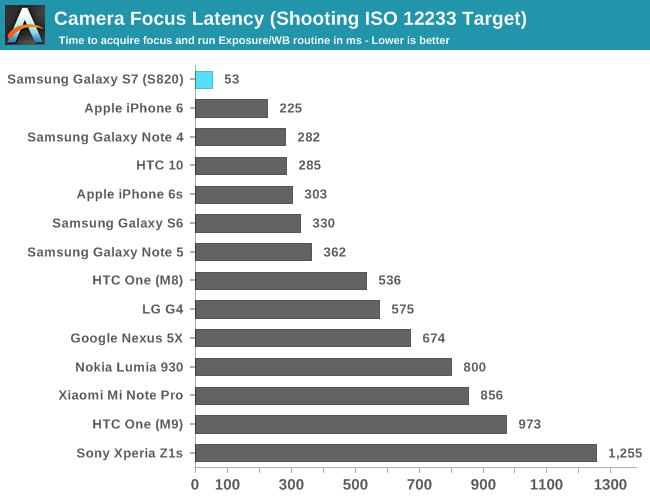
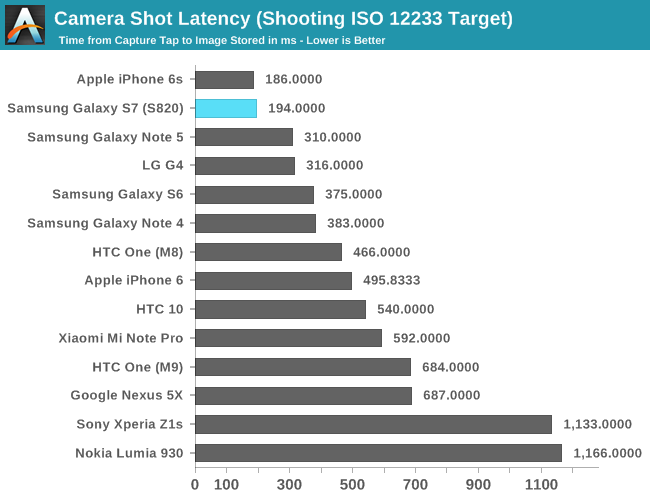
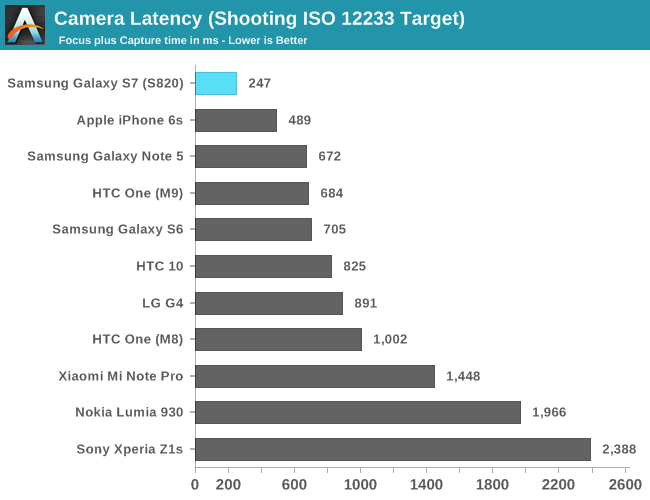
It’s probably not a surprise, but the Galaxy S7 is really, absurdly quick to take photos and focus. There is nothing out there that can realistically match the dual pixel AF system in the Galaxy S7, especially once you get into low light scenarios where traditional PDAF systems are overwhelmed by noise that can’t be easily canceled out. Samsung’s sheer prowess in semiconductor design and manufacture is really showing here, even in the best case.


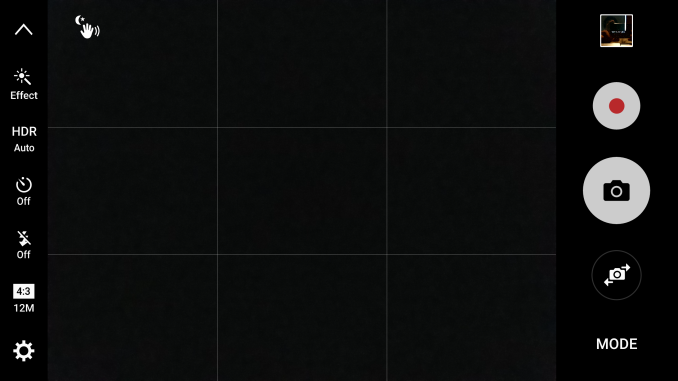
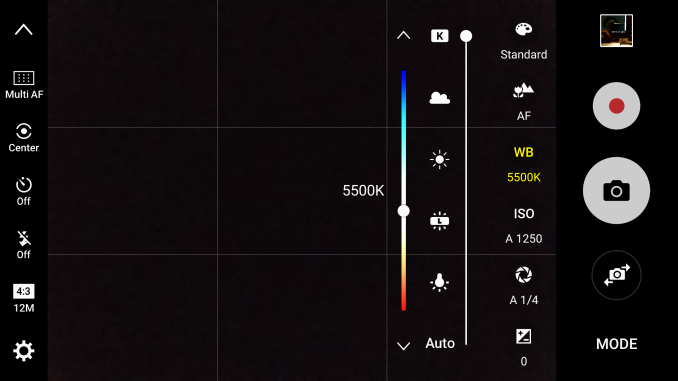
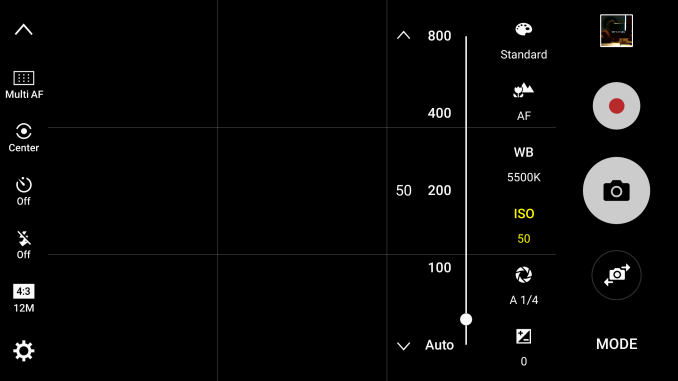








266 Comments
View All Comments
10basetom - Tuesday, July 5, 2016 - link
I would say the Exynos model is a little better than the SD820, but not significantly so.lilmoe - Tuesday, July 5, 2016 - link
No. It's a lot better. Almost generational. I went on a weekend trip with a friend who has a SD variant, the differences were too significant to the point he bought the Exynos variant....Even the camera processing is better. The Samsung sensor is even better than Sony's as well.
Ratman6161 - Tuesday, July 5, 2016 - link
As I read the article, I was sort of wondering at Samsung's rational for having two different versions. The Exynos seems to win a lot of the benchmarks and overall seems like the better SOC. I know I've been very happy with the 7420 in my Note 5.MonkeyPaw - Tuesday, July 5, 2016 - link
They may not be able to produce enough of them, so they dual source.adramaleck - Tuesday, July 5, 2016 - link
From my understanding the radio is part of the SOC on both chips. The US (Verizon and Sprint) is the only major market where CDMA is still in use. So in the rest of the world Samsung can sell one model which supports GSM frequencies and their own SOC. However, since Verizon (and I assume Sprint) require CDMA support in order for them to allow the phone on their network, Samsung probably find it more cost effective to use the Qualicom chip instead of adding support to the Exynos or producing their own.lilmoe - Wednesday, July 6, 2016 - link
What I was hoping for is a comprehensive deep dive of the differences in hardware of the GS7 series.The "true" GS7 models are equipped with Exynos SoCs and all-made-by Samsung parts (including camera sensor). The rest are mix and match units that are comparable to the rest of the "generic" premium flock of devices (including the G5 and HTC 10), in which share common components and only differ in design.
I seriously wouldn't have minded a review that craps all over Samsung for this deliberate variety in handset hardware, but instead we get a rather lazy attempt of a review where the author is trying really hard to be underwhelmed. Totally not worth the wait...
SunnyNW - Thursday, July 7, 2016 - link
This^. I visit the site quite often but have to agree "Totally not worth the wait..." I was under the impression that the delay might be to give us a detailed deep-dive into the different SOC architectures, you know the Kryo core and the new custom M1 from Samsung. Instead I am having a hard time understanding why it took so long to deliver this review, considering it as a whole...lolipopman - Tuesday, October 4, 2016 - link
Are you just going to disregard the GPU benchmarks? Or the fact that the throttling on Exynos is far more horrendous?Amazingly delusional.
zeeBomb - Saturday, July 9, 2016 - link
Holy crap. About time...rohanneo - Tuesday, July 5, 2016 - link
OH MY GOD!! I can't believe it. Been waiting for this article since months!!Really unprofessional of you guys to take TWO months for TWO parts of ONE REVIEW!! Be better next time.